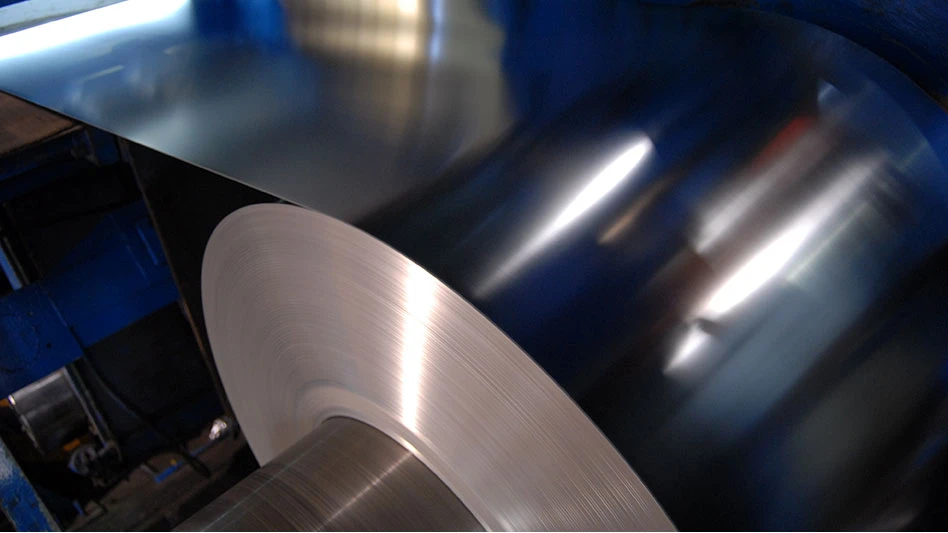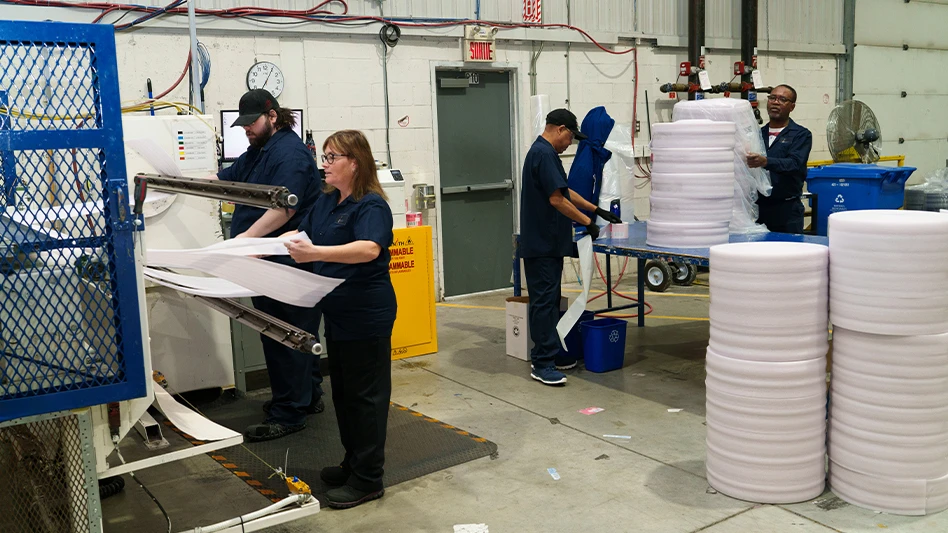But now the town is home to State Rubber & Environmental Solutions LLC, a company operating what it claims is one of the newest, most sophisticated crumb rubber processing facilities in the United States, and possibly in the world.
Topic of Conversation.
State Rubber owes its origins to a conversation between its Vice President Jerry Woosley and a Canadian tire processor he met at a trade show."It was 1999 and my wife Debra and I were in Nashville for the ITRA show," says Woosley. "As a 25-year tire dealer and re-treader, I was attending the show to see what options were available to me for the scrap tires I was generating. I met a Canadian couple whose company was already well established in crumb rubber processing, and they firmly believed that crumb was the best way to go."
Woosley continues, "They invited me to visit their facility, I went and was intrigued enough to come back to Denver City and talk it over with a group that I felt would seriously consider a crumb plant here. That started things rolling."
|
The State System |
|
The system in place at State Rubber & Environmental Solutions LLC, Denver City, Texas, is designed to take in tires from a 250-mile radius and generate high-quality crumb material in a range of sizes. Tires are brought into the Denver City plant and fed into a Saturn 72-44 BGHT shredder—designed for re-circulation with a vibratory screen—for primary size reduction. The resulting 3-inch chips are passed along to a Granutech Model 80 Grizzly which reduces them to material in the 5/8-inch to 3/4-inch range while liberating better than 95 percent of the steel. After magnetic separation, the material is routed to a Granutech G-3 granulator which further reduces product size to about 1/4 inch. It then undergoes three stages of fiber separation: first through a Granutech air separation unit, then over a modified vibratory screener and, finally, through a vacuum gravity bed separator/de-stoner. The final step in the system, a refiner mill with a final pass over another gravity bed separator, results in clean crumb as small as minus-200 mesh. Custom blending and packaging finish the cycle. State Rubber’s Operations Manager Dan Swanson says flexibility is key to the plant’s success. "We are currently processing about 4,000 pounds an hour and, at that rate, will probably average about 1.5 million tires a year. However, the system is also designed for expansion, so we are geared up for almost any eventuality." |
Woosley says the decision to look into a tire processing plant became more than just an opportunity to meet his own needs; it was also a chance to diversify and improve Denver City’s economy.
"This town took a pretty big hit when oil’s downturn occurred in the 1980s. We lost a lot of good people who moved, either with their jobs or to seek work elsewhere. Several of the people who became involved initially with this project saw this as a way for the town itself to benefit.
EQUIPPED AND READY.
Once it was determined that the project itself would be feasible, Woosley and several others—including local businessmen Lee Kidd and Joe Kay—started the process of selecting the right crumb rubber processing system.In many ways, this was more challenging than getting investors to back the project, says Kay, who owns an electrical contracting company in Denver City and serves as State Rubber’s president.
"There’s no denying we did our homework in advance," he says. "We visited a number of crumb rubber plants of differing sizes and utilizing different approaches. We saw everything from equipment that had promise, to some overseas equipment that we literally couldn’t understand," Kay recalls. "It was an exhaustive process that took better than four years, but it enabled us to see what was out there and make our judgment based on that info.
"I truly feel that five years ago would have been too soon to get into this business. Given the advances in equipment technology, I’d say we timed it pretty well," Kay adds.
Woosley says the prominence of Granutech-Saturn, based in Grand Prairie, Texas, in the crumb rubber market played a big role in guiding their decision, but it was not the only factor. "Granutech had something that we really wanted: the ability to supply a full system. So we focused on talking to them. They took us to visit several of their installations in different parts of the country, and seeing those operations, coupled with the level of service they were providing, steered us toward them as the primary equipment supplier for our system."
With a system in mind and a tentative site selected, Kay, Kidd, Woosley and several others went to the Denver City Economic Development Corp. (DCEDC) to present their idea and to begin the process of financing the project.
"Like us, the people from the DCEDC also saw this as a great opportunity for the community to benefit from the revenue the plant would generate, from the people that would come to Denver City to conduct business and so on," says Kay.
The DCEDC proved receptive. "They started making contacts to put together a group of investors interested in seeing this project come about," says Kay. "Today, there are 54 investors—stretching from Dallas to New Mexico—who have a stake in the company. Seven of those who brought a particular area of hands-on expertise to bear in these early stages: Lee, Jerry, Josh Parker, Ross Hilburn, Gene Day, John Thomas and myself, have been designated company directors," he says.
Construction for the State Rubber plant started in August 2003, and the company celebrated with a ribbon cutting and its first bag of crumb material May 5, 2004—five years to the day that Woosley first visited the Canadian tire processing plant.
|
Cleaning Up |
|
Although the nation’s scrap tire stockpiles are growing smaller and fewer, according to the Scrap Tire Management Council, Washington, several good-sized cleanup contracts are still being arranged. The state of Michigan has targeted 28 stockpile or dumping sites for clean up, and has issued $2.9 million in grant money to 31 applicants to help boost tire recycling at the sites. The money was issued under the Scrap Tire Cleanup Program, developed by the state of Michigan’s Department of Environmental Quality. In Ohio, the state’s Environmental Protection Agency has ordered the owner of a Toledo-based salvage company to clean up an estimated 15,000 scrap tires that are illegally disposed of on the property. The orders requires the business to take immediate mosquito control measures and requires the company to establish proper storage piles and fire lanes within 30 days and maintain them until the tires are disposed. In Nebraska, a company that set up shop as a tire recycling operation is being ordered to remove en estimated 1 million scrap tires (some shredded, some whole) from two different sites in the state. The state’s Department of Environmental Quality says the company accumulated more than 600,000 tires at its facility in Wisner, Neb., even after the DEQ had ordered the site to be cleaned up. At another site, once considered a wetland, some 430,000 buried tires were discovered. |
THE WAITING MARKET.
State Rubber’s depth of preparation extended past system design and into identifying—and securing—markets for its products. Today the company’s fine mesh material is shipped primarily for use as an asphalt additive in roadbed construction and repair. However, the firm made certain to avoid limiting itself to one market."There is a wide range of uses for this material out there," says Kidd, a Denver City oil field developer. "And we are finding new uses seemingly every day. We are already supplying some material to companies involved in molded rubber products and we have a handle on customers who are seeking material for use in other applications like running and walking tracks, equestrian arenas, as underlayment in athletic field turf, for use in roping arenas and more. We’ve even had people talk to us about extracting oil from our product. I really don’t think we’ll have a problem finding uses for the material given the versatility of this system."
That versatility includes the option of using only part of the system. "There are customers who use rubber product that is of the same size as material exiting our Grizzly. Obviously, if we can generate a decent revenue stream and only use part of the system, that material is being produced with less operating cost attached to it," Woosley says. "We have the capability to do that and, by all means, are considering every option available to us."
Kidd is optimistic that the system the company has installed will continue to serve State Rubber well.
The author submitted this story on behalf of Granutech-Saturn Systems, Grand Prairie, Texas.

Explore the March 2005 Issue
Check out more from this issue and find your next story to read.
Latest from Recycling Today
- Nucor names new president
- DOE rare earths funding is open to recyclers
- Design for Recycling Resolution introduced
- PetStar PET recycling plant expands
- Iron Bull addresses scrap handling needs with custom hoppers
- REgroup, CP Group to build advanced MRF in Nova Scotia
- Oregon county expands options for hard-to-recycling items
- Flexible plastic packaging initiative launches in Canada





